《吡啶及其衍生物》PPT课件
- 格式:ppt
- 大小:274.00 KB
- 文档页数:67
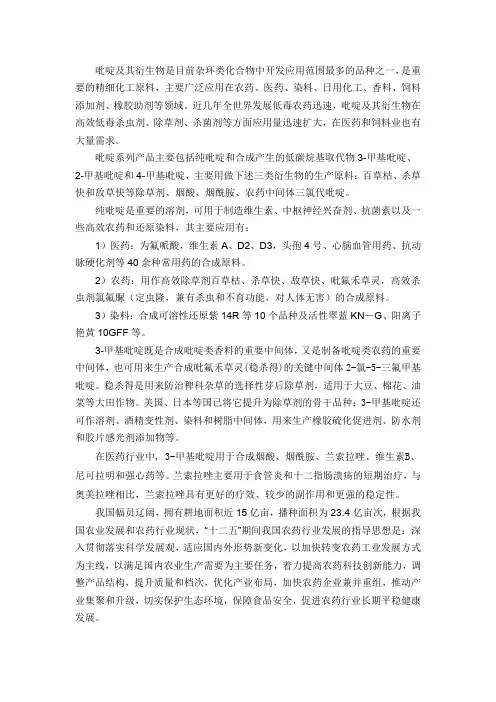
吡啶及其衍生物是目前杂环类化合物中开发应用范围最多的品种之一,是重要的精细化工原料,主要广泛应用在农药、医药、染料、日用化工、香料、饲料添加剂、橡胶助剂等领域。
近几年全世界发展低毒农药迅速,吡啶及其衍生物在高效低毒杀虫剂、除草剂、杀菌剂等方面应用量迅速扩大,在医药和饲料业也有大量需求。
吡啶系列产品主要包括纯吡啶和合成产生的低碳烷基取代物3-甲基吡啶、2-甲基吡啶和4-甲基吡啶,主要用做下述三类衍生物的生产原料:百草枯、杀草快和敌草快等除草剂、烟酸、烟酰胺、农药中间体三氯代吡啶。
纯吡啶是重要的溶剂,可用于制造维生素、中枢神经兴奋剂、抗菌素以及一些高效农药和还原染料,其主要应用有:1)医药:为氟哌酸,维生素A、D2、D3,头孢4号、心脑血管用药、抗动脉硬化剂等40余种常用药的合成原料。
2)农药:用作高效除草剂百草枯、杀草快、敌草快、吡氟禾草灵,高效杀虫剂氯氟脲(定虫隆,兼有杀虫和不育功能,对人体无害)的合成原料。
3)染料:合成可溶性还原紫14R等10个品种及活性翠蓝KN-G、阳离子艳黄10GFF等。
3-甲基吡啶既是合成吡啶类香料的重要中间体,又是制备吡啶类农药的重要中间体,也可用来生产合成吡氟禾草灵(稳杀得)的关键中间体2-氯-5-三氟甲基吡啶。
稳杀得是用来防治稗科杂草的选择性芽后除草剂,适用于大豆、棉花、油菜等大田作物。
美国、日本等国已将它提升为除草剂的骨干品种;3-甲基吡啶还可作溶剂、酒精变性剂、染料和树脂中间体,用来生产橡胶硫化促进剂、防水剂和胶片感光剂添加物等。
在医药行业中, 3-甲基吡啶用于合成烟酸、烟酰胺、兰索拉唑、维生素B、尼可拉明和强心药等。
兰索拉唑主要用于食管炎和十二指肠溃疡的短期治疗,与奥美拉唑相比,兰索拉唑具有更好的疗效、较少的副作用和更强的稳定性。
我国幅员辽阔,拥有耕地面积近15亿亩,播种面积为23.4亿亩次,根据我国农业发展和农药行业现状,“十二五”期间我国农药行业发展的指导思想是:深入贯彻落实科学发展观,适应国内外形势新变化,以加快转变农药工业发展方式为主线,以满足国内农业生产需要为主要任务,着力提高农药科技创新能力,调整产品结构,提升质量和档次,优化产业布局,加快农药企业兼并重组,推动产业集聚和升级,切实保护生态环境,保障食品安全,促进农药行业长期平稳健康发展。
![1[1].1万吨年吡啶及其衍生物](https://uimg.taocdn.com/de6af4c5b8f67c1cfad6b8aa.webp)
安徽氯碱化工集团有限责任公司1.1万吨/年吡啶及其衍生物一、项目名称:1.1万吨/年吡啶及其衍生物二、建设单位:安徽氯碱化工集团有限责任公司三、法人代表:方立贵项目负责人:周杰联系电话:0551-传真:0551-四、企业概况:安徽氯碱化工集团有限责任公司是由合肥化工厂于1997年12月28日改制而成,2001年9月成功实现债转股,新公司注册资本金为3.683亿元人民币,现正积极运作上市,自2003年8月进入上市辅导期。
经过几十年的发展,该公司已成为安徽省最大的氯碱化工企业、全国化工百强企业、国家大型一档企业,银行信用等级AAA。
现有职工3026人,其中各类专业技术人员750人;企业占地面积77万平方米,建筑面积35万平方米。
公司主要产品及生产能力如下:1)烧碱10万吨/年,其中离子膜碱5万吨/年(含片碱2万吨/年),金属阳极隔膜碱5万吨/年;2)盐酸2万吨/年;3)液氯6万吨/年;4)聚氯乙烯 5万吨/年,其中糊状树脂3万吨/年,悬浮树脂2万吨/年;5)甲酸钠法保险粉4万吨/年;6)18%杀虫双水剂、杀虫单、虱螟单农药3万吨/年;7)草甘膦除草剂0.25万吨/年等。
公司共有16个产品,其中有11个产品分别获省、部级以上优质产品称号;公司于2002年通过ISO9001质量体系认证。
五、项目建设的必要性:吡啶及其衍生物是煤化工产品链的下游产品,主要产品有吡啶、3-甲基吡啶、其它吡啶混合物及烟酸/烟酰胺。
吡啶及其衍生物是农药、医药等领域的重要中间体或溶剂,其下游产品多,产品链长,辐射面大。
吡啶主要用于农药合成,如生产百草枯、敌草快、毒死蜱、甲基毒死蜱等。
多年来,我国吡啶类化合物一直依赖进口,价格较高,抑制了下游产品的研究开发,严重影响了我国农药、医药及其它精细化工产品的发展。
随着除草剂百草枯、敌草快、杀虫剂毒死蜱在中国市场的不断开发,预计吡啶的消费在中国将有明显的增长。
吡啶也是化学医药生产的重要原料,我国目前生产的二十一大类化学药中,有十二类与吡啶相关。
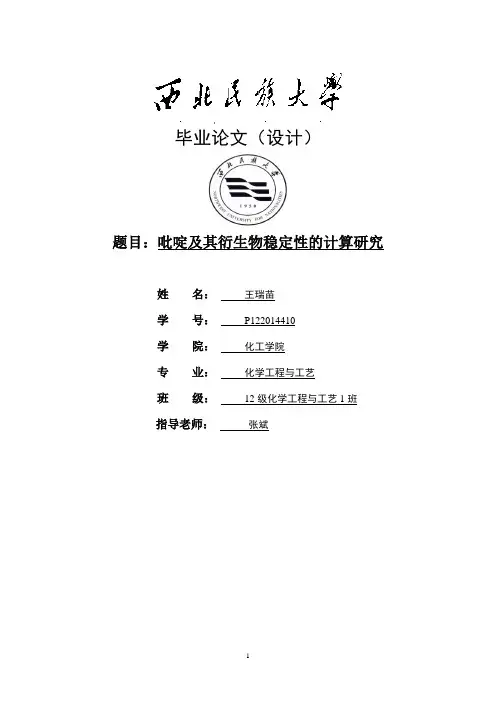
毕业论文(设计)题目:吡啶及其衍生物稳定性的计算研究姓名:王瑞苗学号:P122014410学院:化工学院专业:化学工程与工艺班级:12级化学工程与工艺1班指导老师:张斌诚信声明此毕业论文是本人在导师的认真指导下,对我这大学四年学习的总结和检阅,此篇论文是本人独立进行实验的研究结果。
除文中已加标注引用的内容外,论文中不包括其他个人或集体已经发表或撰写过的研究成果,也不含其他人已经发表过或使用过的材料。
对本文的研究做出重要贡献的个人及相关导师,均在文中明确标明。
特此申明。
声明人:时间:年月日目录摘要 (1)1.前言 (3)1.1 绪论 (3)1.1.1 吡啶及其衍生物的研究意义 (3)1.1.2 吡啶及其衍生物的研究现状 (3)1.2 吡啶 (4)1.2.1 吡啶的物理性质 (4)1.2.2 吡啶的化学性质 (4)1.2.3 吡啶的存在与合成方法 (5)1.2.4 吡啶的用途 (5)1.3 2-氯吡啶 (5)1.3.1 2-氯吡啶的物理性质 (5)1.3.2 2-氯吡啶的制备方法 (6)1.3.3 2-氯吡啶的用途 (6)1.4 4-甲基吡啶 (7)1.4.1 4-甲基吡啶的物理性质 (7)1.4.2 4-甲基吡啶的化学性质 (7)1.4.3 4-甲基吡啶的制备方法及用途 (8)1.5 2-氨基吡啶 (8)1.5.1 2-氨基吡啶的物理性质 (8)1.5.2 2-氨基吡啶的制备方法及用途 (9)1.6 2-羟基吡啶 (9)1.6.1 2-羟基吡啶的物理性质 (9)1.6.2 2-羟基吡啶的化学性质 (10)1.6.3 2-羟基吡啶的制备方法及用途 (10)1.7 2-乙烯基吡啶 (10)1.7.1 2-乙烯基吡啶的物理性质 (10)1.7.2 2-乙烯基吡啶的化学性质 (11)1.7.3 2-乙烯基吡啶的制备方法及用途 (11)2. 实验方法与计算 (12)2.1 实验方法简介 (12)2.2 计算方法及概念简介 (12)3. 实验结果与讨论 (16)3.1 分子结构图 (16)3.2 电荷 (17)3.3 键长 (19)3.4 键角 (21)3.5 频率 (22)3.5.1 吡啶频率 (22)3.5.2 2-氯吡啶频率 (23)3.5.3 4-甲基吡啶频率 (24)3.5.4 2-氨基吡啶频率 (24)3.5.5 2-羟基吡啶频率 (25)3.5.6 2-乙烯基吡啶频率 (26)3.6 偶极距 (27)3.7 分子轨道 (27)3.8 静电势 (30)4. 结论 (33)4.1 实验结论 (33)参考文献 (34)答谢 (35)吡啶及其衍生物稳定性的计算研究专业:化学工程与工艺姓名:王瑞苗指导教授:张斌摘要从头算计算法是一种基本的量子化学计算方法。
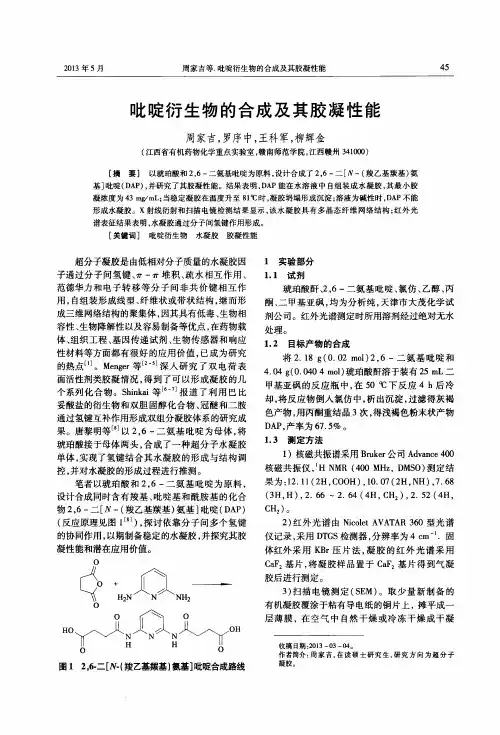
2013年5月周家吉等.吡啶衍生物的合成及其胶凝性能45吡啶衍生物的合成及其胶凝性能周家吉,罗序中,王科军,柳辉金(江西省有机药物化学重点实验室,赣南师范学院,江西赣州341000)[摘要]以琥珀酸和2,6一二氨基吡啶为原料,设计合成了2,6一二[Ⅳ一(羧乙基羰基)氨基]吡啶(D A P),并研究了其胶凝性能。
结果表明,D A P 能在水溶液中自组装成水凝胶,其最小胶凝浓度为43m g /m L ;当稳定凝胶在温度升至8l ℃时,凝胶坍塌形成沉淀;溶液为碱性时,D A P 不能形成水凝胶。
x 射线衍射和扫描电镜检测结果显示,该水凝胶具有多晶态纤维网络结构;红外光谱表征结果表明,水凝胶通过分子间氢键作用形成。
[关键词]吡啶衍生物水凝胶胶凝性能超分子凝胶是由低相对分子质量的水凝胶因子通过分子间氢键、7r 一仃堆积、疏水相互作用、范德华力和电子转移等分子间非共价键相互作用,自组装形成线型、纤维状或带状结构,继而形成三维网络结构的聚集体,因其具有低毒、生物相容性、生物降解性以及容易制备等优点,在药物载体、组织工程、基因传递试剂、生物传感器和响应性材料等方面都有很好的应用价值,已成为研究的热点…。
M enger 等旧。
51深人研究了双电荷表面活性剂类胶凝情况,得到了可以形成凝胶的几个系列化合物。
Shi nkai 等M 。
7o 报道了利用巴比妥酸盐的衍生物和双胆固醇化合物、冠醚和二胺通过氢键互补作用形成双组分凝胶体系的研究成果。
唐黎明等旧1以2,6一二氨基吡啶为母体,将琥珀酸接于母体两头,合成了一种超分子水凝胶单体,实现了氢键结合其水凝胶的形成与结构调控,并对水凝胶的形成过程进行推测。
笔者以琥珀酸和2,6一二氨基吡啶为原料,设计合成同时含有羧基、吡啶基和酰胺基的化合物2,6一二[Ⅳ一(羧乙基羰基)氨基]吡啶(D A P)(反应原理见图l 旧1),探讨依靠分子间多个氢键的协同作用,以期制备稳定的水凝胶,并探究其胶凝性能和潜在应用价值。

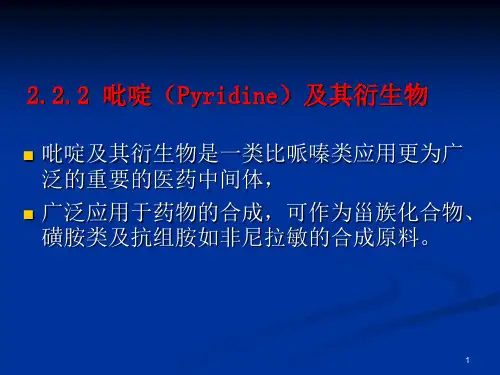


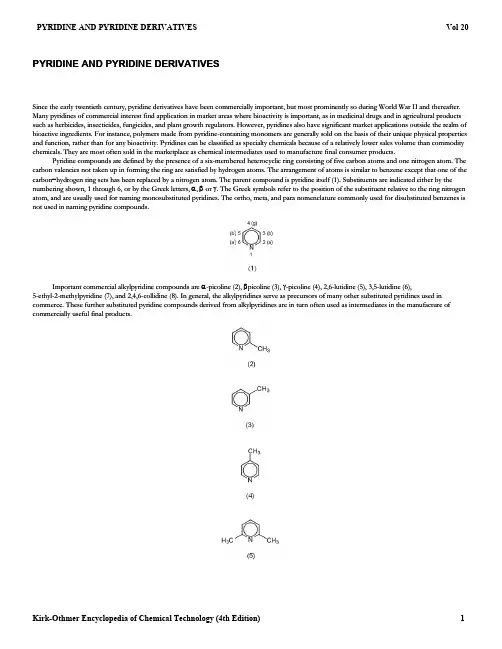
Since the early twentieth century, pyridine derivatives have been commercially important, but most prominently so during World War II and thereafter.Important commercial alkylpyridine compounds are PYRIDINE AND PYRIDINE DERIVATIVESMany pyridines of commercial interest find application in market areas where bioactivity is important, as in medicinal drugs and in agricultural products such as herbicides, insecticides, fungicides, and plant growth regulators. However, pyridines also have significant market applications outside the realm of bioactive ingredients. For instance, polymers made from pyridine-containing monomers are generally sold on the basis of their unique physical properties and function, rather than for any bioactivity. Pyridines can be classified as specialty chemicals because of a relatively lower sales volume than commodity chemicals. They are most often sold in the marketplace as chemical intermediates used to manufacture final consumer products.Pyridine compounds are defined by the presence of a six-membered heterocyclic ring consisting of five carbon atoms and one nitrogen atom. The carbon valencies not taken up in forming the ring are satisfied by hydrogen atoms. The arrangement of atoms is similar to benzene except that one of the carbon −hydrogen ring sets has been replaced by a nitrogen atom. The parent compound is pyridine itself (1). Substituents are indicated either by the numbering shown, 1 through 6, or by the Greek letters, α, β or γ. The Greek symbols refer to the position of the substituent relative to the ring nitrogen atom, and are usually used for naming monosubstituted pyridines. The ortho, meta, and para nomenclature commonly used for disubstituted benzenes isnot used in naming pyridine compounds.α-picoline (2), βpicoline (3), γ-picoline (4), 2,6-lutidine (5), 3,5-lutidine (6),5-ethyl-2-methylpyridine (7), and 2,4,6-collidine (8). In general, the alkylpyridines serve as precursors of many other substituted pyridines used in commerce. These further substituted pyridine compounds derived from alkylpyridines are in turn often used as intermediates in the manufacture ofcommercially useful final products.As is the case with most specialty organic compounds, pyridine sales are generally not publicized, and industrial processes for their manufacture The physical properties of pyridines are the consequence of a stable, cyclic, 6- Physical propertyValue 40.2are either retained as trade secrets or patented (see P ATENTS AND TRADE SECRETS ). Up to about 1950, most pyridines were isolated from coal-tar fractions;however, after 1950 synthetic manufacture began to take an ever-increasing share of products sold. By 1988, over 95% of all pyridines were produced by synthetic methods.Pyridine was first synthesized in 1876 (1) from acetylene and hydrogen cyanide. However, α-picoline (2) was the first pyridine compound reported to be isolated in pure form (2). Interestingly, it was the market need for (2) that motivated the development of synthetic processes for pyridines during the 1940s, in preference to their isolation from coal-tar sources. The basis for most commercial pyridine syntheses in use can be found in the early work of Chichibabin (3). There are few selective commercial processes for pyridine (1) and its derivatives, and almost all manufacturing processes produce (1)along with a series of alkylated pyridines in admixture. The chemistry of pyridines is significantly different from that of benzenoids. Pyridines undergo some types of reaction that only highly electron-deficient benzenoids undergo, and do not undergo some facile reactions of benzenoids, such as Friedel-Crafts alkylation and C-acylation, for example.Physical Propertiesπ-electron, π-deficient, aromatic structure containing a ring nitrogen atom.The ring nitrogen is more electronegative than the ring carbons, making the two-, four-, and six-ring carbons more electropositive than otherwise would be expected from a knowledge of benzenoid chemistries. The aromatic π-electron system does not require the participation of the lone pair of electrons on the nitrogen atom; hence the terms weakly basic and π-deficient used to describe pyridine compounds. The ring nitrogen of most pyridines undergoes reactions typical of weak, tertiary organic amines such as protonation, alkylation (qv), and acylation.Liquid pyridine and alkylpyridines are considered to be dipolar, aprotic solvents, similar to dimethylformamide or dimethyl sulfoxide. Mostpyridines form a significant azeotrope with water, allowing separation of mixtures of pyridines by steam distillation that could not be separated by simple distillation alone. The same azeotropic effect with water also allows rapid drying of wet pyridines by distillation of a small forecut of water azeotrope.Pyridine. Many physical properties of pyridine are unlike those of benzene, its homocyclic counterpart. For instance, pyridine has a boilingpoint 35.2°C higher than benzene (115.3 vs 80.1°C), and unlike benzene, it is miscible with water in all proportions at ambient temperatures. The much higher dipole moment of pyridine relative to benzene is responsible, in significant part, for the higher boiling point and water solubility. Benzene and pyridine are aromatic compounds having resonance energies of similar magnitude, and both are miscible with most other organic solvents. Pyridine is a weak organic base (p K a =5:22), being both an electron-pair donor and a proton acceptor, whereas benzene has little tendency to donate electron pairs or accept protons. Pyridine is less basic than aliphatic, tertiary amines. Table 1 lists some physical properties of pyridine, and Table 2 compares physical properties of pyridine to some alkyl- and alkenylpyridine bases.Table 1. Physical Properties of Pyridine enthalpy of fusion at ¡41:6±C , kJ/molenthalpy of vaporization, kJ/mol bat 25°C 115.26°C35.11Water azeotrope CAS Structure Freezing Boiling Density,Index of Water20[110-86-1](1)79.10¡115.30.9830 1.5102 5.2293.641.32-picoline ¡ 5.2(6)atom, such as critical temperature, °C346.8critical pressure, MPac5.63enthalpy of formation, gas at 25°C, kJ/molb140.37Gibbs free energy of formation, gas at 25°C, kJ/mol b190.48heat capacity, gas at 25°C, J/(K ¢mol)78.23ignition temperature, °C 550explosion limit, %1.7−10.6surface tension, liquid at 25°C, mN =m(=dyn =cm)36.6viscosity, liquid at 25°C, mPa(=cP)0.878dielectric constant, liquid at 25°C, ε13.5thermal conductivity, liquid at 25°C, W/(K ¢m)0.165aRef. 4.bTo convert kJ to cal, divide by 4.184.cTo convert MPa to atm, multiply by 9.87.Table 2. Physical Properties of Pyridine, Alkyl-, and Alkenylpyridine Derivatives aCompoundRegistry Number numberMol wtpoint, °Cpoint, °Cd 204refraction,n 204solubility bat 20°C,g/100 mLp K a at °C, inwater cBp d, °C Water, %pyridine41:6e f ,g[109-06-8](2)93.13¡66:7129.50.9462 1.5010e 5.9693.5483-picolineg[108-99-6](3)93.13¡18:3143.90.957 1.5043e 5.6396.7634-picoline f ,g[108-89-4](4)93.13 3.7144.90.9558 1.5058e5.9897.463.52,3-lutidine [83-61-9](58)107.1615:5161.50.9491 1.508513.36.572,4-lutidine [108-47-4]107.16¡64158.70.9325 1.5000e6.6371.567.42,5-lutidine [589-93-5]107.16¡15:71570.9331 1.500510.06.402,6-lutidine [108-48-5](5)107.16¡6:1143.70.923 1.4977e6.7293.351.53,4-lutidine [583-58-4]107.16¡10:6179.10.9534 1.5081 6.463,5-lutidine [591-22-0]107.16¡6:6172.70.944 1.5049 3.3 6.152,4,6-collidine [108-75-8](8)121.18¡44:5170.40.913 1.4981 3.67.435-ethyl-2-meth yl-pyridine[104-90-5](7)121.18¡70:9178.30.9208 1.4974 1.298.4722-vinylpyri-din e[100-69-6](23)105.14110h 0.9746 1.5509 2.75 4.9897.062.04-vinylpyri-din e [100-43-6]105.14121h0.9881.55252.915.6298.076.6aRef. 5, unless otherwise noted bRef. 6.cRef. 7.dRef. 8.eMisciblef Ignition temperature =535±C for (2) and 500°C for (4).gExplosion limit =1:48:6% for (2) and 1.3−8.7% for (3) and (4)hAt 20 kPa (150 mm Hg).Other Pyridine Bases. The nucleophilicity and basicity of pyridines can be reduced by large, sterically bulky groups around the nitrogentert -butyl in the 2- and 6-positions. Sterically undemanding groups like methyl tend to increase basicity relative to parent pyridine, asexpected. Electron-withdrawing substituents can also reduce pyridine basicity and nucleophilicity. 2,6-Dichloropyridine [2402-78-0] is sterically hindered and also contains strong electron-withdrawing substituents. As such, it cannot be titrated by acid, even by using extremely acidic media such as perchloricacid in acetic acid solvent.Generally, hydrophobic substituents on the pyridine ring reduce water solubility, polar ones capable of hydrogen bonding as acceptor or donor,increase it.Table 3 gives the corresponding physical properties of some commercially important substituted pyridines having halogen, carboxylic acid, ester,carboxamide, nitrile, carbinol, aminomethyl, amino, thiol, and hydroxyl substituents.Table 3. Physical Properties of Substituted Pyridines Water solubility 202-chloropyridine [109-09-1]113.5516887 1.627 2.10.9picolinic acid1.166 1.519 5.013.5 1.361.031.053 1.5431 1.431.065>8.3aRegistry Number number point, °Cpoint, °C d 204refraction,n 20D at 20°C, g/100 mLp K a at °C in water (17)¡46:5−170 1.205d1.5322.50.52,6-dichloropyridine [2402-78-0]147.99−89211ef2-bromopyridine[109-04-6]158.00192−194194.81.5714g[98-98-6]123.11134−136h1.4896 5.39nicotinic acid i [59-67-6](27)123.11236−239h 1.473 1.7 4.81isonicotinic acidj [55-55-1]123.11314−315h0.5 4.86methyl picolinate [2459-07-6]137.1418.792k 2.21ethyl nicotinate [614-18-6]151.178−10223−2241.107 1.50404.48picolinamide [1452-77-3]122.13110 dec 143l 1.3918 2.10nicotinamide [98-92-0](26)122.13128−131 1.401120 3.332-cyanopyridine [100-70-9](14)104.1126−28212−215 1.081 1.5290¡0:263-cyanopyridine [100-54-9](25)104.1150−52206 1.159 1.5252m4-cyanopyridine [100-48-1](15)104.1179195n4.01.903-pyridylcarbinol [100-55-0](30)109.13¡6:5266 1.124 1.5455o 4.904-pyridylcarbinol [586-95-8]109.1357−59146p o5.332-picolylamine [3731-51-9]108.1481203o 8.84-picolylamine [3731-53-1]108.14¡7:62291.0661.5493o4.392-mercaptopyridine [2637-34-5]111.17128−130¡1:074-mercaptopyridine [4556-23-4]111.17184−1862-pyridone [142-08-5](16)95.10107294>100 1.253-hydroxypyridine [109-00-2](40)95.101263.64.94-pyridone [626-64-2](38)95.10150181q >1003.232-aminopyridine [504-29-0](35)94.1258211100 6.93-aminopyridine [462-08-8](33)94.1262.2248 1.24>1005.984-aminopyridine [504-24-5](34)94.121592731.2509.24-dimethylamino-pyri dine [1122-58-3](24)122.17112162r 7.69.5aMeasured in the laboratories of Reilly Industries, Inc., unless otherwise noted.bRef. 6.cRef. 7.dRef. 9.eInsoluble.fCannot be protonated.g2-Carboxypyridine.hSublimes.i3-Carboxypyridine.j4-Carboxypyridine.kAt 4 Pa (0.03 mm Hg).lAt 2.7 kPa (20 mm Hg).mAt 50°C.nAt 80°C.oMiscible.At 1.3 kPa (10 mm Hg).knowledge of molecular structure, that seems to work well for pyridine compounds. Such a prediction can be used to estimate real physical properties of Chemical reactivity of pyridines is a function of ring aromaticity, presence of a basic ring nitrogen atom, Ring-atomic centers can undergo attack by electrophiles, easily at the ring nitrogen and less easily at ring carbons. Nucleophilic attack is also possible at Reactive halogen compounds, alkyl halides, and activated alkenes give quaternary pyridinium salts, such as (12). Oxidation with peracids gives p qAt 0.133 kPa (1 mm Hg).rAt 6.7 kPa (50 mm Hg).Quantitative Structure-Property Relationships. A useful way to predict physical property data has become available, based only on apyridines without having to synthesize and purify the substance, and then measure the physical property.The relationship between the structure of a molecule and its physical properties can be understood by finding a quantitative structure −property relation- ship (QSPR) (10). A basis set of similar compounds is used to derive an equation that relates the physical property, eg, melting point or boiling point, to structure. Each physical property requires its own unique QSPR equation. The compounds in the basis set used for QSPRs with pyridines have sometimes been quite widely divergent in respect to structural similarity or lack of it, yet the technique still seems to work well. The terms of the equation are composed of a coefficient and an independent variable called a descriptor. The descriptors can offer insight into the physical basis for changes in the physical property with changes in structure.The same strategy can be used to relate chemical reactivity, catalytic ability, and bioactivity (10) of pyridine compounds with their structure.Although such a prediction is still in its formative stage, early results have been encouraging.Chemical Propertiesπ-deficient character of the ring, large permanent dipole moment, easy polarizability of the π-electrons, activation of functional groups attached to the ring, and presence of electron-deficient carbon atom centers at the α- and γ-positions. Depending on the conditions of the chemical transformation, one or more of these factors can give rise to the observed chemistry. The chemistry of pyridines can be divided into two categories: reactions at the ring-atomic centers, and reactions at substituents attached to the ring-atomic centers.REACTIONS AT RING ATOMSring carbons or hydrogens.Electrophilic Attack at Nitrogen. The lone pair on pyridine (1) (p K a =5:22) reacts with electrophiles under mild conditions, withprotonic acids to give simple salts, with Lewis acids to form coordination compounds such as (9) [2903-67-5], and with transition metals to form complex ions, such as (10) [24444-58-4]. The complex ion pyridinium chlorochromate [67369-53-3] (11) is a mild oxidizing agent suitable for the conversion ofalcohols to carbonyl compounds.pyridine N -oxides, such as pyridine N -oxide itself [694-59-7] (13), which are useful for further synthetic transformations (11).electron-donating substituents are attached to the ring. Knowledge of this fact has resulted in the widespread use of pyridine as a solvent for reactions A modification of the Reissert-Henze reaction employing benzoyl chloride and (CH Pyridine and its methyl derivatives, (2), (3), and (4), undergo amination with sodium amide at the 2-position eg, 2-amino-3-methylpyridine Electrophilic Attack at Carbon. Electrophilic attack at a C-atom in pyridines is particularly difficult unless one or more stronginvolving electrophilic species. Pyridine undergoes nitration in low yield (15%) to give 3-nitropyridine [2530-26-9] (12) whereas pyridine N -oxide is nitrated at position 4 to give 4-nitropyridine N -oxide [1124-33-0] in high yield, and 2- and 4-aminopyridines may be dinitrated (13). The chlorination of pyridine and picolines (2), (3), and (4), on the other hand, is of great commercial importance (14).Nucleophilic Attack at Carbon or Hydrogen. Only the strongest of nucleophiles (eg, ¡NH 2) can replace a hydrogen in pyridine.However, N-oxides and quaternary salts rapidly undergo addition, followed by subsequent transformations (12).The Feely-Beavers procedure (eq. 1) provides a method for the introduction of a cyano group (9), principally at the 2-position, to give compoundssuch as (14).3)3SiCN gives good yields of 2-cyano pyridine (14) from pyridine N -oxide (13) (15).Methylpyridinium quaternary salts, such as (12), undergo oxidation in alkaline solution in the presence of potassium ferricyanide to give2-pyridones, eg, N -methyl-2-pyridone [694-85-9] (16). Frequently nucleophilic attack at position 2 by excess hydroxide leads to ring opening; this and synthetically useful recyclizations have been reviewed (17).Treatment of pyridine N-oxide (13) with acetic anhydride leads chiefly to 2-pyridone (16) formation (eq. 2) (11).[1603-40-3] and 2-amino-5-methylpyridine [1603-41-4] from (3) (eq. 3). This Chichibabin reaction is most important for introduction of a 2-aminosubstituent, which may be replaced readily by many other groups (18).The N-oxides readily undergo nucleophilic addition followed by elimination, which forms the basis of several useful syntheses of 2-substitutedPyridine undergoes 2- and 4-alkylation with Grignard reagents, depending on whether free metal is present (19). Free metal gives mixtures or Treatment of pyridine (1) with sodium metal in ethanol gives piperidine been, owing to low conversions and poor selectivity (21). However, some pyridinium salts have been found to undergo potentially useful regiospecific 4-Cyanopyridine (15) reacts with ketones not bearing an pyridines. Chlorination of (13) with POCl 3to give 2-chloropyridine (17) is a good example (eq. 4); some chlorination may occur also at C-4 (11).exclusive 4-alkylation. Substituent-directed metallation (eq. 5) has become an important approach to the synthesis of disubstituted pyridines (12). For example, 2-fluoro-pyridine [372-48-5] reacts with butyllithium and acetaldehyde to give a 93% yield of alcohol [79527-61-1].[1910-42-5] (18); however, dimerization to 4,4′-bipyridine [553-26-4] (19)is favored in aprotic solvents (12).The 4,4′-bipyridine (19) formed is a precursor of the important herbicide Paraquat [1910-42-5](20) (20).Free-Radical Attack at Carbon. Homolytic substitution of pyridines has not been as thoroughly studied as heterolytic processes havereactions (22). Protonated pyridines readily undergo acylation by acyl radicals, generated by abstracting a hydrogen atom from an aldehyde, eg,2-acetyl-4-cyanopyridine [37398-49-5]from protonated 4-cyanopyridine (eq. 6).α-hydrogen in the presence of sodium metal to afford a tertiary alcohol (a precursor of azacyclonol) in high yield, eg, the reaction of (15) and benzophenone yields the tertiary benzyl alcohol [1620-30-0](23):ring or those attached to a benzene ring. Carbanions can be formed readily at alkyl carbons attached at the 2- and 4-positions. This increased chemical An industrially important example is the condensation of 2-Vinylpyridine (23) came into prominence around 1950 as a component of latex. Butadiene and styrene monomers were used with (23) to make a Cyanopyridines are usually manufactured from the corresponding picoline by catalytic, vapor-phase ammoxidation (eq. 7) in a fixed- or fluid-bed Compound (27) may also be obtained directly by oxidation of REACTIONS OF SUBSTITUTED PYRIDINESCarbon Substituents. Alkyl groups at positions 2 and 4 of a pyridine ring are more reactive than either those at the 3-position of a pyridinereactivity has been used to form 2- and 4-(phenylpropyl)pyridines, eg, 4-(3-phenylpropyl)pyridine [2057-49-0](21) (24).α- (2) or γ-picoline (4) with aqueous formaldehyde to form the correspondingethanolpyridines, 2-ethanolpyridine [104-74-2] (22) and 4-ethanolpyridine [5344-27-4], respectively, followed by dehydration of the alcohols to give 2- (23)or 4-vinylpyridine.terpolymer that bonded fabric cords to the rubber matrix of automobile tires (25). More recently, the ability of (23) to act as a Michael acceptor has been exploited in a synthesis of 4-dimethylaminopyridine (DMAP) (24) (26). The sequence consists of a Michael addition of (23) to 4-cyanopyridine (15),replacement of the 4-cyano substituent by dimethylamine (taking advantage of the activation of the cyano group by quaternization of the pyridine ring),and base-catalyzed dequaternization (retro Michael addition). 4-Dimethylaminopyridine is one of the most effective acylation catalysts known (27).reactor (28). 3-Cyanopyridine (25) is the most important nitrile, as it undergoes partial or complete hydrolysis under basic conditions to give niacinamide [98-92-0](26) or niacin (nicotinic acid) (27), respectively (29).β-picoline (3) or by exhaustive oxidation of 5-ethyl-2-methylpyridine (7), followed by decarboxylation of the initially formed pyridine-2,5-dicarboxylic acid [100-26-5] (28) (eq. 8) (30).Hydrogenation of 3-cyanopyridine (25) in the presence of ammonia gives 3-picolylamine Treatment of cyanopyridines such as (25) with a Grignard reagent yields a ketone (32). A carboxylic ester is obtained by reaction of the nitrile (25)Isonicotinic hydrazide Nicotinamide which are insoluble in the media. On heating, these nitramines rearrange intermolecularly to nitroaminopyridines having the nitro group mainly adjacent [3731-52-0] (29); however, hydrogenation in the presenceof hydrogen chloride affords the corresponding 3-carbinol (30) (31).with sodium alkoxide, followed by hydrolysis (33).[54-83-3] (isoniazid) (31) is still an important tuberculostat (34). It may be obtained by reaction of isonicotinic esters such as ethyl isonicotinate [1570-45-2], or the 4-nitrile (15), with hydrazine.[98-92-0] (26) and isonicotinamide [1453-82-3] (32) undergo Hofmann rearrangements to form 3- (33) and 4-aminopyridine (34),respectively (35). This provides an important route for the manufacture of these amines.Nitrogen Substituents. 4-Aminopyridine (34) and 2-aminopyridine (35) react with cold nitric acid to give the corresponding nitramines,to the amino group (13). From (34) the products are the intermediate 4-nitraminopyridine [26482-55-3] and 4-amino-3-nitropyridine [1681-37-4] (eq. 9).The antibacterial agent nalidixic acid shown in equation 2, compound (16).Exclusive O-alkylation of (16) (eq. 10) may be achieved using ethyl iodide and silver carbonate (39); the product is 2-ethoxypyridine Reaction of 2-aminopyridine (35) with N -acetylsulfanilyl chloride, followed by hydrolysis, gives sulfapyridine [144-83-2](36), an antibacterial (36).[389-08-2] (37) is formed by reaction of 2-amino-6-methylpyridine [1824-81-3] with analkoxymethylenemalonic ester to form the 1,8-naphthyridine carboxylic ester followed by alkylation and ester hydrolysis (37).Oxygen Substituents. The presence of oxygen or sulfur attached to the ring can affect the chemistry of those compounds throughtautomerism. This phenomenon in the pyridine series has been well studied and reviewed (38). An example of 2-pyridone −2-pyridinol tautomerism was The compounds 2- (16) and 4-pyridone (38) undergo chlorination with phosphorus oxychloride; however, 3-pyridinol (39) is not chlorinated similarly. The product from (38) is 4-chloropyridine [626-61-9]. The 2- (16) and 4-oxo (38) isomers behave like the keto form of the keto −enoltautomers, whereas the 3-oxo (39) isomer is largely phenolic-like, and fails to be chlorinated (38).[14529-53-4].Heating 2- or 4-alkoxypyridines, with or without acid catalyst, induces intermolecular migration of the alkyl group on oxygen to the ring nitrogen to form N -alkyl-2- or N -alkyl-4-pyridones (39).The N-oxide function has proved useful for the activation of the pyridine ring, directed toward both nucleophilic and electrophilic attack (see [19829-29-9]Oxidation of a pyridinethione gives the corresponding sulfonic acid, eg, 6-carboxy-2-pyridinesulfonic acid Tetrachloropyridine-4-thiol A MINE OXIDES ). However, pyridine N-oxides have not been used widely in industrial practice, because reactions involving them almost invariably produce at least some isomeric by-products, adding to the cost of purification of the desired isomer. Frequently, attack takes place first at the O-substituent, with subsequent rearrangement into the ring. For example, 3-picoline N-oxide [1003-73-2] (40) reacts with acetic anhydride to give a mixture of pyridone products in equal amounts, 5-methyl-2-pyridone [1003-68-5] and 3-methyl-2-pyridone [1003-56-1](11).Alkylation at the oxygen atom of N-oxides is also a facile process, and the entire N-substituent may be removed with base (eq. 11).Treatment of N-oxides with phosphorus trichloride provides a good method for deoxygenation (eq. 12) to obtain the free base.Sulfur Substituents. Acetylation and alkylation of pyridinethiones usually take place on sulfur (39). An exception to this is 4-pyridinethionewhich is acetylated on nitrogen. Displacement of thioethers can be achieved with hydroxide or amines (eq. 13) (40). Thioether functionalgroups can also be removed by reduction (39).[18616-02-9] from 6-carboxy-2-pyridinethione [14716-87-1](eq. 14) (41).[10357-06-1] (41) reacts with chlorine in carbon tetrachloride to give a sulfenyl chloride (42), which is fairly stable. The sulfenyl chloride may be converted into a number of derivatives (39).at the 2-Chloropyridine Amines or ammonia replace activated halogens on the ring, but competing pyridyne The 4-chloro group can be removed selectively when pentachloropyridine Halogen Substituents. Halogen functional groups are readily replaced by nucleophiles, eg, hydroxide ion, especially when they are attachedα- or γ-position of the pyridine ring. This reaction has been exploited in the synthesis of the insecticide chlorpyrifos [2921-88-2] (43) (42), and the insecticide triclopyr [55335-06-3] (44) (14,43). 2,3,5,6-Tetrachloropyridine [2402-79-1] reacts with caustic to form the hydroxylated material [6515-38-4],which then can be used to form (44) and (43).N -oxide [20295-64-1] reacts with sodium hydrosulfide to give pyrithione [1121-31-9] (45), the zinc salt of which is used as anantifungal agent, most prominently in shampoos (44).[7129-66-0] (46) formation is observed for attack at 3- and 4-halo substituents, eg, in 3-bromopyridine [626-55-1] (39). The most acidic hydrogen in 3-halopyridines (except 3-fluoropyridine) has been shown to be the one in the 4-position. Hence, the 3,4-pyridyne is usually postulated to be an intermediate instead of a 2,3-pyridyne. Product distribution (40% (33) and20% (34)) tends to support the 3,4-pyridyne also.[2176-62-7] (47) is treated with zinc to form symmetrical 2,3,5,6-tetrachloropyridine (45).Organometallics. Pentachloropyridine (47) forms Grignard reagent (48) by the entrainment method (eq. 15) (46). Addition of CO 2 produces4-carboxy-2,3,5,6-tetrachloropyridine [19340-26-2].Metallation of 2-picoline N -oxide [931-19-1] with butyllithium followed by addition of the electrophilic cyclohexanone leads to two carbinolSubstituent-directed metallations are being used for the synthesis of disubstituted pyridines. A 2-substituent directs to the 3-position, and a Pyridine ring syntheses (48) can be classified into essentially two categories: ring synthesis from nonheterocyclic compounds, and synthesis from other Synthesis of 4,6-disubstituted-2-picolines and their corresponding nicotinamides has been developed using The formation of pyridine derivatives from products (47) (4% (49) [34277-46-8] and 20% (50) [34277-59-3]).3-substituent usually directs to the 4-position; however, in the presence of N,N,N ′N ′;-tetramethylethylenediamine (TMEDA), 2-metallation may be achieved (12).Synthesisring systems. The synthesis of pyridine derivatives by transformations on the pyridine ring atoms and side-chain atoms have been considered in the previous section.Ring Synthesis From Nonheterocyclic Compounds. These methods may be further classified based on the number of bonds formedduring the pyridine ring formation. Synthesis of α-picoline (2) from 5-oxohexanenitrile is a one-bond formation reaction (eq. 16) (49). The nitrile is obtained by reaction between acetone and acrylonitrile (50). If both reaction steps are considered together, the synthesis must be considered a two-bondforming one, ie, formation of (2) from acetone and acrylonitrile in a single step comes under the category of two-bond formation reaction.The formation of quinoline [91-22-5](51) from aniline and acrolein involves formation of two bonds during the ring synthesis.β-aminocrotonitrile (52) and α,β-unsaturated compounds, where R 1=R 2=aryl(51).α, β-unsaturated aldehydes and ammonia involves formation of three bonds during the ring synthesis.For example, with an α, β-unsaturated aldehyde, both 2,5-substituted as well as 3,4-substituted pyridines can be obtained, depending on whether a 1,2-(eq. 17) or 1,4-addition (eq. 18) occurs with ammonia. Reactions are performed in the vapor phase with catalysts.。
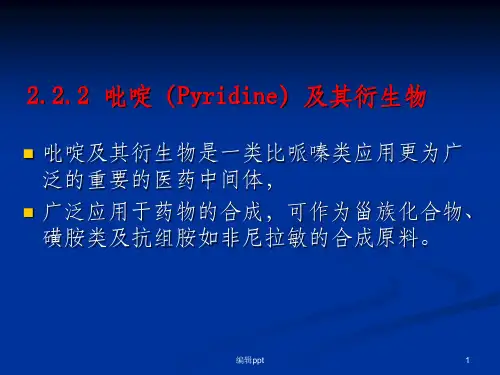

第一章联吡啶类衍生物的制备及对金属离子的识别作用镧系金属离子由于其化学性质相似,定量测量镧系金属离子成了一大难题。
现有的仪器测量方法如火焰光度检测法、原子吸收光谱法、电子显微镜分析法和中子活化分析法,大都存在测量成本高,样品需要量大并且不能连续检测的缺点。
光化学传感器是近年来发展起来的检测各种阴离子、阳离子和分子新方法。
具有简单、经济、能在比较大的浓度范围内光响应等优点[1]。
这种传感器的常需要有联接在识别基团载体上的发光基团[2]。
荧光激发的形状和位置以及载体识别的过程被转换为荧光团的荧光信号的变化,通常识别基团上给电子原子的拓扑、电荷、化学性质对传感器的选择性和键合效率起着至关重要的作用[3,4]。
三价铕离子(Eu3+)由于其荧光发射强并且寿命长,在生物医药领域有广泛的应用,特别是肿瘤成像的荧光标记和荧光分析。
但是,水溶液中Eu3+的选择性荧光传感器却鲜有报道[5,6]。
联吡啶(bpy)是最常用的能和金属离子配位形成带电化合物的配体, 通过改变环上杂原子的种类、数目和位置能精细调节联吡啶化合物的电子和光谱性质[7]。
本文获得了一种新型的非共轭化合物1-(N-甲基-吡咯)-2-(4,4`-二甲基-2,2`-联吡啶)-乙醇(dbpy)(路线.1),通过对其光化学性质的研究,表明其对Eu3+具有高度选择性。
2.1实验部分2.1.1仪器和试剂美国NICOLET NEXUS 470 FT-IR型傅立叶红外光谱仪,KBr压片,400~4000cm-1;意大利Perkin-Elemer 240 型元素分析仪;德国NETZSCH STA449C 型差热-热重分析仪,氮气气氛,10 ºC/min;日本岛津UV-2450型紫外可见分光光度仪,800-190 nm;德国BRUKERAC-P 400 型核磁共振仪,溶剂CDCl3,内标TMS;DHG-9140A型电热恒温鼓风干箱(上海-恒科技有限公司);DZF-6051型真空干燥箱(上海-恒科技有限公司);RE-52C型旋转蒸发器(巩义市予华仪器有限公司)。
矿产资源开发利用方案编写内容要求及审查大纲
矿产资源开发利用方案编写内容要求及《矿产资源开发利用方案》审查大纲一、概述
㈠矿区位置、隶属关系和企业性质。
如为改扩建矿山, 应说明矿山现状、
特点及存在的主要问题。
㈡编制依据
(1简述项目前期工作进展情况及与有关方面对项目的意向性协议情况。
(2 列出开发利用方案编制所依据的主要基础性资料的名称。
如经储量管理部门认定的矿区地质勘探报告、选矿试验报告、加工利用试验报告、工程地质初评资料、矿区水文资料和供水资料等。
对改、扩建矿山应有生产实际资料, 如矿山总平面现状图、矿床开拓系统图、采场现状图和主要采选设备清单等。
二、矿产品需求现状和预测
㈠该矿产在国内需求情况和市场供应情况
1、矿产品现状及加工利用趋向。
2、国内近、远期的需求量及主要销向预测。
㈡产品价格分析
1、国内矿产品价格现状。
2、矿产品价格稳定性及变化趋势。
三、矿产资源概况
㈠矿区总体概况
1、矿区总体规划情况。
2、矿区矿产资源概况。
3、该设计与矿区总体开发的关系。
㈡该设计项目的资源概况
1、矿床地质及构造特征。
2、矿床开采技术条件及水文地质条件。